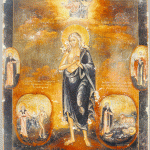Perhaps you are new to Ásatru. Or perhaps you've been invited to a Heathen friend's wedding or seasonal event. If you haven't been to one of our gatherings before, there is a lot you might want to know, and we'll talk about only a little of it here. This short description covers some of the practical issues, so your new experience goes smoothly for everyone.
Ásatru (pronounced OW-sa-troo) is also known as Heathenry. It is a reconstructionist religion, continuing in modern context the beliefs of Northern Europe prior to roughly 1000 C.E. But the historical material is sparse, and we often don't have much to go on. As a result, you will find a lot of diversity in Heathen rituals from one group to the next. The points mentioned here will provide you with a good set of ground rules: things to do, and things to avoid, as you're getting to know us.
Things to Do
There are three principal kinds of Heathen rituals: blót, sumbel, and seidh.
Blót (rhymes with boat) and blessing come from the same root word far back in linguistic history. A blót can take many specific forms. It involves an assembly of participants and a leader who manages the rite. Before a blót begins, there may be instruction from the leader on what is about to happen. These instructions might contradict what is described here. Listen carefully and use your good sense before, during, and after the blót.
Many blóts include the passing of a horn of mead or ale. At some blóts, a non-alcoholic horn is provided for those who do not drink. Please choose whichever horn you prefer. Most horns are curved; keep the curved point pointed down or sideways, or you will end up taking an unexpected bath. If you have, or think you may have, something the rest of us would rather not have, or if you are uncomfortable drinking from a communal vessel, or if you simply prefer not to drink, just raise the horn and then pass it along. No one that matters will think any the less of you. If the horn was given to you by one of the people conducting the blót, give it back to that person when you are finished with it.
Sumbel (rhymes with bumble) is a ritual that focuses entirely on the passing of the horn. With each pass around the circle, some verbal contribution by each participant can be made, but is not required. Each round has a theme that will be announced beforehand. A common sumbel is the Toast-Boast-Oath; another is Gods-Ancestors-Teachers. If you are not clear on the given themes, let us know, and someone in the circle will be happy to help you. Not all sumbels have three rounds: there may be more or less. And just in case this sounds like a drinking game to you, rest assured that it is not: words spoken in sumbel are not casual speech. As explained earlier, you do not have to drink from the horn. As explained later, never make an oath unless you will carry it out. Oaths are not expected of you, and oath rounds often proceed with no oaths being made.
Seidh (rhymes with bathe) involves questioning a seer. Its mythic aspects are hard to explain in a short space. Blót and sumbel are religious rites, but seidh is in a different category and not all Heathens practice it. Seidh is often performed outdoors, and usually at night. A seidh can go for a long time, and leaving before it is finished is disruptive. If you plan to attend, have someone explain it to you beforehand, consider what you will need to get to the site and back safely, what clothing might be necessary for your comfort, and whether to take something to sit on.
You'll often see people dressed in archaic clothing styles at Ásatru gatherings. This is a point of preference for them, and you're welcome to do so, too, if you wish. Wearing such clothing does not make you more Heathen; not wearing such does not make you less. Also, there is the question of how much clothing is enough. Unlike some other pagan traditions, ritual nudity is not found at public Heathen rites, and is extremely uncommon even at very private ones. You may sometimes see a lot of skin, but participants are generally expected to be dressed in a street-legal fashion.
You may see people carrying weapons. Yes, they are real. No, a person carrying them is not going to attack you, unless you do things that normal well-mannered law-abiding modern citizens aren't likely to do. This is not a costume event; until you get to know us well, it's better that you not go armed. Even then, you probably won't. While edged weapons are commonplace, most groups require that firearms be left at home or in the car. However, even groups that permit heavy artillery often have at least some rituals where no weapons of any kind are allowed (this includes pocketknives), so listen carefully to the instructions given beforehand. Failure to heed this may require restarting or even abandoning the rite.





